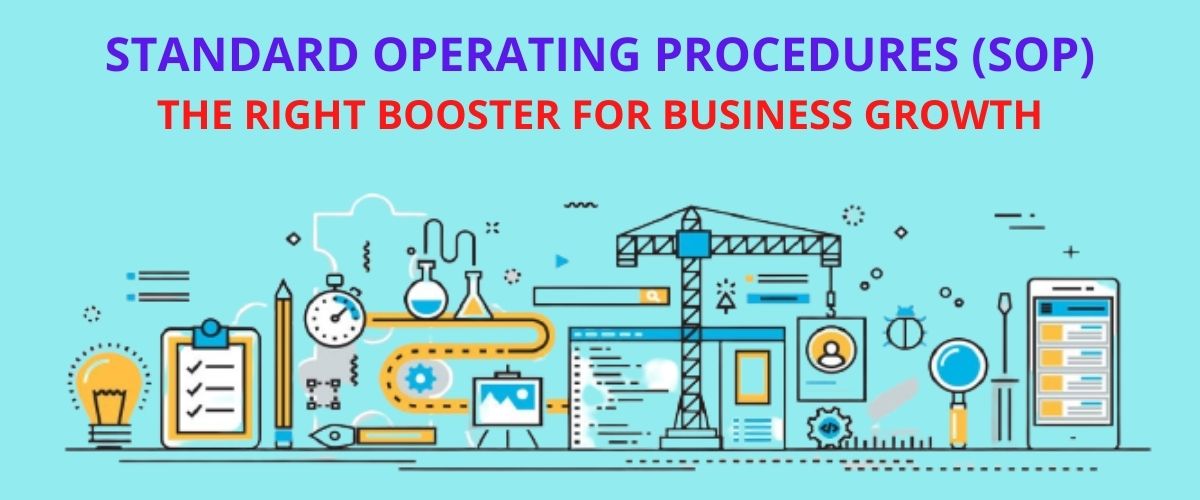
As Business Owners are you encountering these challenges practically on a day-to-day basis?
- Too many clients to serve.
- Too many employees to manage at the same time.
- Difficulty in maintaining consistency in work output.
- Difficulties in establishing streamlined processes.
- Several other hectic, repetitive tasks.
Then, is there a way to get out of this Mess?
Yes, there is one – Get down to work on your SOP.
A Standard Operating Procedure (SOP) is a set of step-by-step instructions compiled by an organization to help workers carry out routine operations.
SOP aims to achieve:
- Efficiency
- Quality Output
- Uniformity of Performance
SOP seeks to reduce:
- Miscommunication
- Failure to comply with industry regulations.
What Are Standard Operating Procedures (SOPS)?

SOPs are brief, easy-to-understand, and use documents incorporating:
- Action points
- Workflows
Ultimately, SOP creates process flowcharts for performing defined tasks and outlines steps for routine, business-growing actions like:
- Onboarding new customers.
- Serving clients and delivering projects on time.
- Training new employees.
- Managing employees and assigning tasks to both clients and employees.
IBM defines an SOP simply as:
“A set of instructions that describes all the relevant steps and activities of a process or procedure.”
Organizations must know what is needed to complete certain tasks or processes, and an SOP offers that guidance.
SOP describes in detail the implementation of a business policy to include:
- Fulfilling policy requirements- such as regulatory policies, internal standards, and/or industry best practices.
- Mapping the applicable policy, standards, and practices to an explicit, step-by-step set of actions.
- Defining the goals that the process will accomplish, and breaking these into individual steps to achieve that goal.
- Assigning the roles responsible for carrying out each step.
Steps To Create SOPS For Your Business

1. Create a Blueprint for Repetitive Tasks
As your business grows, what duties do you perform every day or week?
Most times, it’s because you only have the process of doing them buried in your head.
It creates a lack of streamlined procedures for getting work done. In turn, you and your employees do one thing today and another tomorrow.
This is simply not the way to scale up your business.
It is, indeed, onerous to:
- Hold people accountable.
- Improve mode of working.
- Grow your business.
Head-buried procedures that fluctuate with mood swings can spell disaster for your business.
It is of paramount interest to create a blueprint when you embark on writing SOPs.
2. Develop a List of your Business Processes
- Talk to your managers, as also employees about duties performed in their jobs almost the same way -daily, weekly, or monthly.
- Review the list.
- Highlight redundant jobs not performed with best practices due to a lack of standardized procedures.
Thus, the need to write standard operating procedures is justified.
Plan the Process
Mobilize your team to outline all the steps they take to deliver results.
3. Outline and Launch Processes
- Communicate with all employees.
- You need to communicate with everyone, and not just managers, who’ll be working on any step or specific task of this process.
- That’s how you keep everyone on the same page and in sync with your standardized procedures.
- Write and review the entire process.
Having communicated with employees, or made it easy for them to communicate with you on specific tasks, take a step back to review your standard operating procedure again.
Essential things to be on the same page on is who is responsible for maintaining and ensuring that each written SOP is followed to the letter.
Doing this helps to ensure each member across your organization reads the same way, but only describes specific jobs in a distinctive manner.
4. Assign and Automate Routine Tasks
Maintain the process and update them at least once a year or as dictated by compulsions of business.

Why Do You Need Standard Operating Procedures (SOPS)?
Need for Standard Operating Procedures emanates from a variety of factors:
- It eliminates the guesswork out of how the company performs essential & repetitive tasks.
- Facilitate quality assurance and quality control for:
- Process management
- Process evaluation, and
- Routine jobs process improvement.
Additional benefits of SOPs are:
- Help to hold employees accountable.
- Acquire a bird-view look on who did what (evaluation) and who didn’t (accountability).
- Improve communication with employees.
- Create a safer work environment.
- Empower employees to perform their job functions safely and consistently by adhering to safety rules attached to every task.
- Lend consistency in operations.
- Creating business flexibility.
Purpose
Define the intent of your SOP and include the goals, objectives, and pain points it aims to solve.
Procedures
Describe operating procedures in detail to properly guide employees into completing a task according to company standards and safety regulations. This includes:
- Clarification of terminology
- Health and safety warnings
- Troubleshooting instructions
- Other necessary or additional steps to complete a task
Scope
Describe the extent and coverage of SOP outlining:
- Where the SOP will be used.
- The people who will be engaging with it or will be impacted.
- Limitations, and expectations.
Responsibilities
Specify the employees or stakeholders involved in the processes and define their roles and responsibilities.
Approval Signatures
For accountability, your SOP should be signed off by key personnel.
Effective Methods For Writing SOP:
1. Selection of Appropriate Format Step by Step
To provide SOPs in the form of a numbered or bulleted list.
2. Hierarchical
This format is suitable for processes that require more detailed and specific instructions to complete.
3. Flowchart
When there are multiple outcomes in a process and decision-making is required, a flowchart will better guide users on what to do per outcome.
4. Follow the 5 Cs
To avoid ambiguity, 5 Cs ensure that SOPs are clear, concise, correct, courteous, and complete.
5. Use Visuals
Use visuals such as videos, or quizzes to translate SOPs into a much digestible format for the employees.
When And Why To Write SOP
- SOP converts policies, goals, missions, and visions into actions.
- SOP gives tangible, real-world guidance to help put appropriate policies into action.
- SOP helps to provide consistency in how tasks are executed throughout an organization.
Numerous organizational benefits that SOPs offers are:
- Help your organization meet compliance standards.
- Adhere to schedules.
- Simplify and maximize production.
- Set safety standards.
- Support training efforts.
- Ensure business activities have no adverse environmental impacts.
- Prevent organizational failures.
Business Value Of SOP
SOP serves as a reference point for operating procedures.
A single SOP is useful to the people directly involved in that task.
A body of SOPs provides high-level context and shows how tasks are related and provide many benefits:
- Helps workers define and learn their role and responsibilities.
- Promotes consistent outcomes.
- Delivers a key step in the implementation and verification of business
- Helps employees learn how to fulfill their responsibilities and communicate what is expected of them.
- Introduces other groups and roles to the team to better understand actions in the larger context of the company.
PROCESS OF WRITING SOP
The process for writing an SOP is unique for each organization and a process that fits your team’s specific needs.
Primary considerations that influence writing SOP are:
- SOP should be easy to read, understand, and use.
- SOP should be actionable.
- SOP should be specific and measurable.
Steps For Compliance In Formation Of SOP
- Due credence to end objective.
- Consider what is expected from the SOP to achieve- all activities, from beginning to end, that are necessary to meet this objective.
- Map out the activities with -a flowchart or diagram to help understand every aspect of the process laying down an outline, scope, and sequence of the relevant procedure.
- Consider which steps can be combined, eliminated, expanded.
Draft Of SOP: Vital Parameters To Conside
1. Title
- Give the title.
- SOP id number.
- Date it was drafted or revised.
- Name of the organization.
- Role, department, or division that it applies to.
- Names and signatures of individuals that drafted or approved it.
2. Procedures
- Start this section with a short introduction that conveys what the SOP is about, what it’s intended to accomplish, and to whom it’s applicable.
- Scope of the SOP any details that are needed to accomplish each step of the procedure.
- Clarification for any ambiguous language, including acronyms or terms that are not widely known.
- Any supplies or equipment that is necessary to complete each step.
3. Additional Sections
- Table of contents
- Troubleshooting tips
- Glossary for defining any acronyms or jargon
How To Craft Functional Utility Of SOP
1. Focus on the Process – Not the Tools
2. Be Concise
An SOP should be short, readable segments that describe how to accomplish a specific task.
3. Write for your Audience
To write your SOP for your audience following factors are relevant:
- Prior knowledge.
- Whether you’re addressing new employees.
- Relevant factors or context Industry-specific language.
- Limit the use of jargon or other specialized terminology that may confuse or mislead the reader.
4. Clearly Define Steps and Roles
- Explicit, actionable steps make it clear what needs to be done.
- Map each step to a responsible party clarifies who should do the work.
- Identify the role(s) responsible to avoid situations where people think somebody else is responsible for a task.
- SOP should always describe what needs to be done and who should do it.
5. Incorporate Input from Relevant Team Members and Stakeholders
6. Testing SOP
- Test the SOP to ensure that it is accurate and usable.
- Further, have other team members test it too.
- This will help in identifying while dealing with any problem areas before its implementation.
7. Regular Review
- SOPs should be updated as changes occur, and reviewed on a regular basis for clarity and correctness.
- Discussing and reviewing a process often results in finding steps that are redundant or obsolete and can be simplified.
- Schedule a review of the SOP at least every 6 to 12 months.
- This will help to identify and update any obsolete areas, using specific and measurable goals, to ensure that the SOP continues to be relevant and helpful to the people who use it.
In Ultimate Analysis
It is evident that SOP help the companies to stay organized, operate smoothly, and lays down the path for the employees to accomplish the assigned goals. It is without any doubt that SOP serves as a potential companion of Business Owners to:
- Reduce training time for the employees.
- Maintain consistency in functioning.
- Enhance productivity and reduce the incidence of error.
- Comply with legal requirements.
- Establish a chain of command.
- Facilitate easy transfer of work.
“Our finest moments are most likely to occur when we are feeling deeply UNCOMFORTABLE, UNHAPPY, OR UNFULFILLED. For it is only such moments, propelled by our discomfort, that we are likely to step out of our ruts and start searching for different ways or TRUE ANSWERS.”
M. Scott Peck



